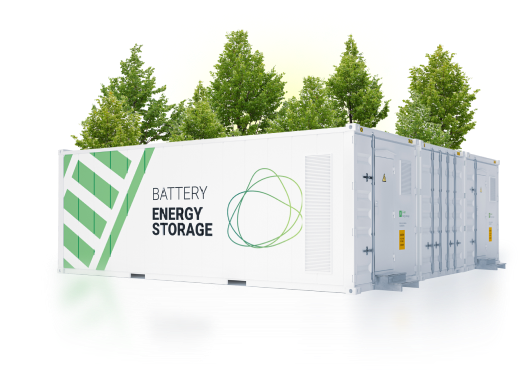|
|
|
Warley Energy Hub | Public Consultation

Clearstone Energy is proposing to develop the Warley Energy Hub – a 200MW battery energy storage facility – on land off St Mary’s Lane, Upminster. This webpage provides an overview of the proposal.
The Energy Hub would store excess electricity available when generation from the UK’s wind turbines and solar farms is higher than demand and release that energy back onto the grid when demand is higher than generation. This network flexibility is urgently needed as we continue to transition UK electricity generation away from gas and coal fired power stations to meet climate change objectives.
The project would connect to National Grid’s Warley Substation. As the grid supply point for homes and business in Havering and Thurrock, Warley substation is a strategically important location for adding battery energy storage to the electricity grid. The project includes a comprehensive package of community benefits to ensure that the local community benefits directly from this local renewable energy project.
Capable of storing energy equivalent to 4 hours power for all homes in Havering and Thurrock when fully charged
Warley Energy Hub Impact

Would displace 108,000 tonnes of CO2 emissions from gas fired power plants each year
Equivalent to planting 5 million trees
+++++++++++++++++++++++++++++++++++++++++++++++++++++++++
Latest News
27th February 2024
Thank you to those residents that attended the drop in session at St Mary’s Church last night. We’ve posted the exhibition boards that we used at the event below.
——————————————————————————————————————-
14th February 2024
We are holding a drop drop in session at St Mary’s Church in North Ockendon on Wednesday 26th February – from 3-7pm – for local residents to meet us and discuss the project.
——————————————————————————————————————-
12th November 2024
We have now submitted a planning application for the project. Plans and accompanying reports can be found on the Havering Borough Council website. The planning application reference number is P1498.24. Members of the public can comment on the application on the Council website.
——————————————————————————————————————
29th July 2024
Thank you to those residents that attended our online consultation event on Monday 22nd July. We’ve posted the presentation for viewing and download below and added additional questions and answers to the Q&A section further down this web page. If you have any further questions or if you would like to discuss the project with us please email us at warley@clearstoneenergy.com.
The pre-application consultation runs until Friday 16th August.
We’d love to get your feedback once you’ve read through our proposals. A digital feedback form for the project can be found here
+++++++++++++++++++++++++++++++++++++++++++++++++++++++
THE CRITICAL ROLE OF BATTERY ENERGY STORAGE
Built for an era of coal and gas fired power stations, the existing UK electricity network needs upgrading to support the deployment of renewable, low carbon energy. The inflexibility of the network is adding costs to bills and failing to deliver the emissions reductions needed to prevent climate change.
Batteries solve one of the biggest challenges facing renewable energy. Matching weather dependent solar and wind electricity with household and business electricity demand.
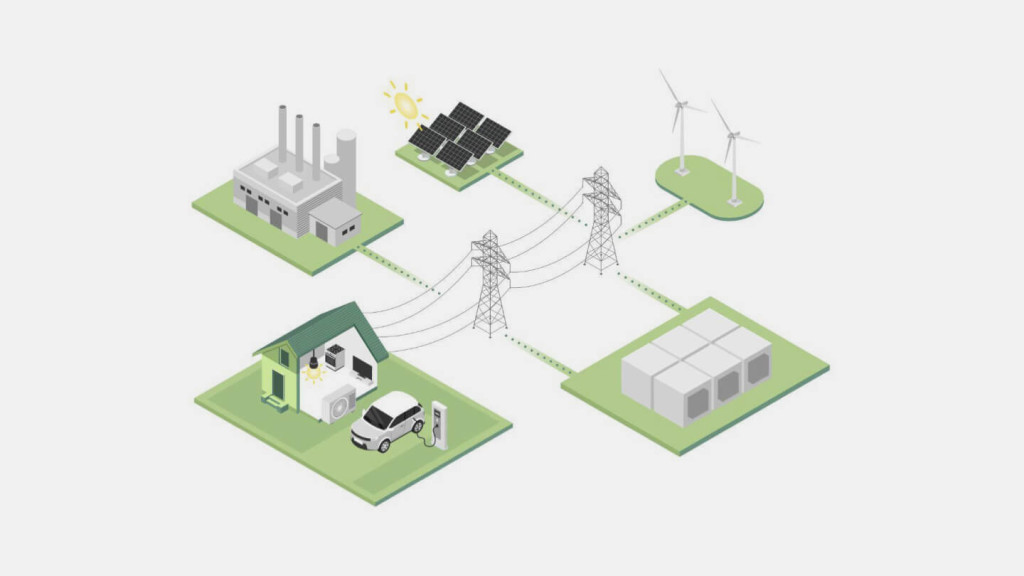
Currently, gas power plants are turned on to supplement wind and solar energy supply and meet peak electricity demand between 7 and 9am and 6 and 8pm
Batteries maximise the amount of renewable energy we can use at home and reduce the number of times we need to turn on a gas fired power plant to meet peak demand, saving money and reducing GHG emissions
Weather dependent wind and solar energy farms often produce more energy than is needed to meet electricity demand overnight and at off peak times during the day
With both supply and demand fluctuating across the day, batteries store energy when there’s more than needed to meet demand and discharge it when there’s less than needed
Proposed Site Layout Plan
The redline boundary on the plan below contains all development work associated with the project. The total site area for the project is just under 6 hectares with the battery facility accounting for 3.7 hectares. Connection to the electricity grid would be via underground cable along Warley Street and Clay Tye Road. The remainder of the site area will benefit from shrub and tree planting to screen views from St Mary’s Lane and create new wildlife habitats.
The batteries would be placed in the northern section of the field adjacent to Warley Street and the railway line, furthest away from properties on St Mary’s Lane. A full noise impact assessment has been conducted to demonstrate that this site layout means that noise generated by the facility would be below ambient noise levels at local properties.
Construction and operational access would be from Warley Street so that vehicles avoid St Mary’s Lane. There is a second emergency access track from St Mary’s Lane to the eastern side of the facility. This would only be used if the main access is blocked.
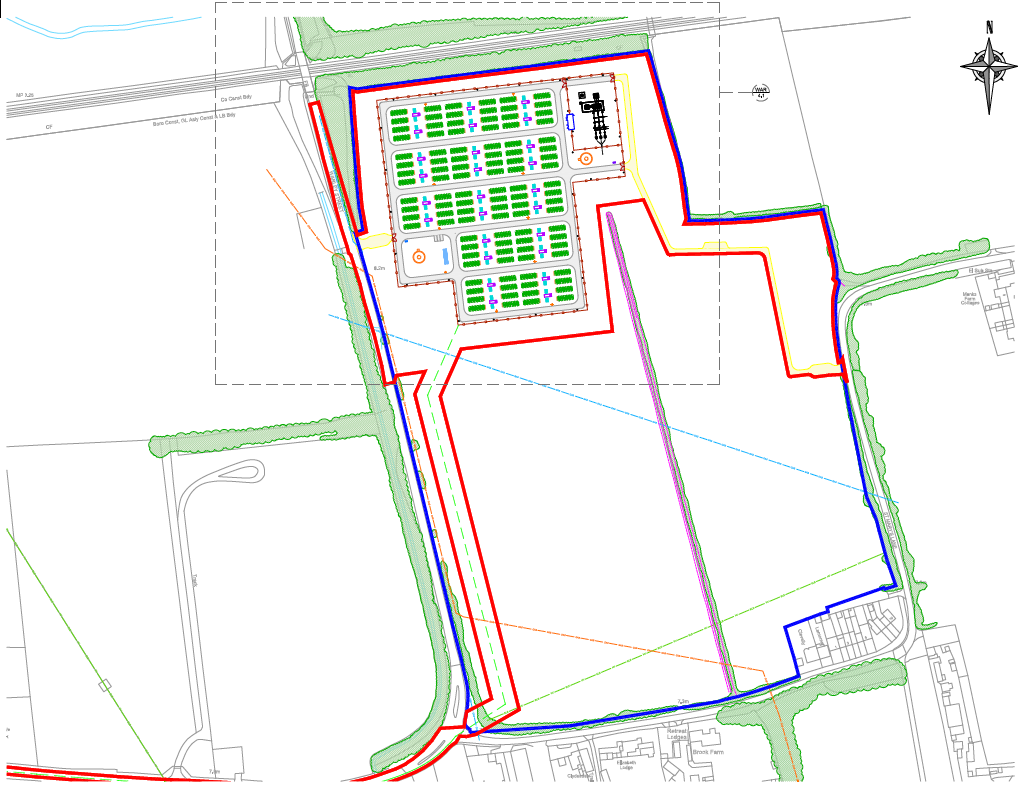
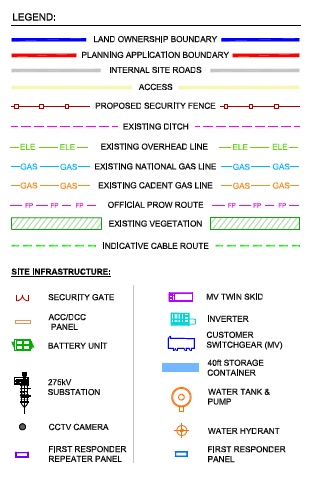
Planting and Biodiversity Plan
All four sides of the proposed facility would be planted with a thick belt of shrubs and trees to effectively screen the facility from nearby properties, footpaths and roads. Species have been chosen to reflect the local area and include beech, birch, blackthorn, dog rose, hawthorn, maple, oak and willow. The new planting would create permanent habitats for the local wildlife identified in ecological surveys including badgers, bats, birds and hedgehogs. This would result in a 43% Biodiversity Net Gain across the 6 hectare site.
=
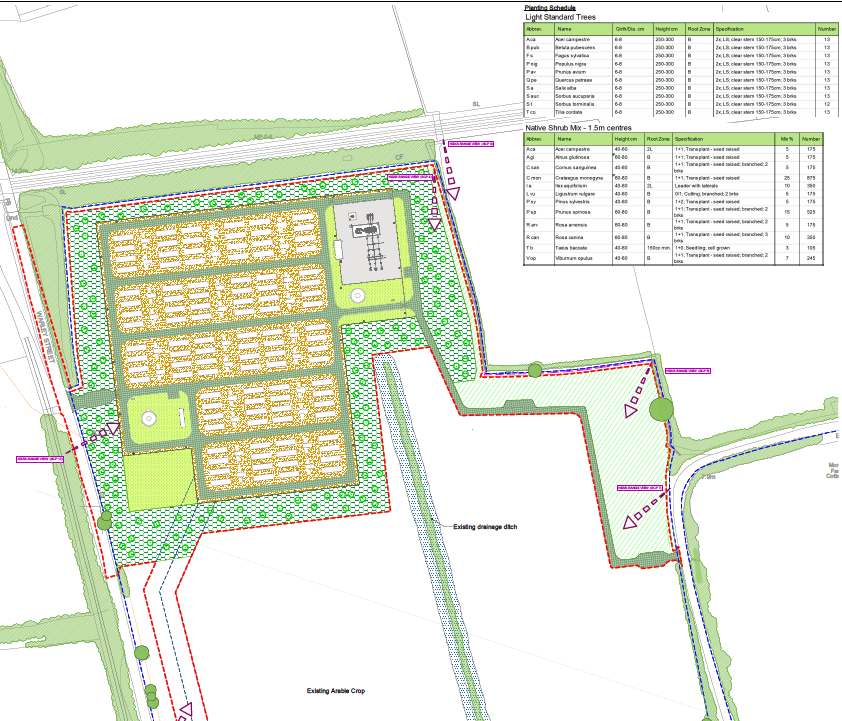
ECOLOGICAL NOTES:
Meadow – The area between the public footpath and emergency access track from St Mary’s Lane would be planted with species rich wildflower meadow mosaic with native scrub planting and tree planting
Scrub and tree screening belt – The facility would be surrounded by a thick belt of native woodland planting, copses and connecting Green Infrastructure planting – including species which are found in neighbouring woodlands
Frequently asked questions
No – while the facility would generate some low-level electrical noise from the inverters, switchgear, and fan equipment this noise would not be perceptible beyond the site boundaries. To demonstrate this, a Noise Impact Assessment has been submitted as part of the planning application.
All Clearstone projects must comply with the standards set out in our comprehensive Battery Safety Standards Plan. Our safety plan draws on best practice from the UK’s National Fire Chiefs Council (NFCC) and the US’s National Fire Protection Agency (NFPA). These standards cover all aspects of the project – technology, site design, installation, operation and emergency response plan – to ensure that it meets the highest safety levels. The London Fire Brigade has been consulted on the project already and will be involved at all stages of its development and operations.
No, this would be a temporary 40-year use of the land, with batteries, other equipment and hard infrastructure removed at the end of the project and the land returned to agricultural use.
The land is privately owned, Clearstone Energy has an agreement in place with the landowner for the use of the land. We have applied for planning permission for the development area outlined on this web page and have no plans to develop the remainder of the field with agricultural use continuing.
Battery units are prefabricated offsite rather than assembled in situ. On site construction will be restricted to the laying of shallow concrete pads for battery containers to sit on and the craning of prefabricated units into position ready for cabling and connection works. As such, project construction would take 12-15 months.
The Lithium-Ion batteries that will be used in the project are not reliant
on scarce raw materials. There are established recycling processes for recovering the most common elements used in battery construction – iron, phosphate and lithium – for re-use.
Typically, there would be two HGVs a day bringing prefabricated units to the site during construction. Construction vehicles will route to the site via the M25, A127 and Warley Street. Once operational, traffic would reduce to a light goods van visiting a couple of times a month.
No, there will be no lighting on site.
The maximum height of the batteries would be 3m. However, these would be screened by existing hedgerows and the proposed new shrub and tree planting.
The project would cost approximately £100 million to build. If the project receives planning consent, Clearstone Energy would seek financing from a bank or investment fund to cover construction costs. Current estimates for the returns from a project like this are 7%.
We sent the project brochure to the closest 70 properties to the project site and a number attended the follow up webinar. We wanted to give those people that are potentially most impacted by the project the opportunity to learn about our plans and provide feedback. The project website is open to all residents and it was good to see residents from further afield join the webinar.
The residents of St Marys Lane have been the primary focus for our public consultation and it was good to see a number on the webinar. The decisions we have made about locating the site (to the north of the field), new planting and noise control have been driven by ensuring that the project presents as little impact as possible for those living closest to the site.
Clearstone Energy sold its battery storage project next to Warley substation to provide funds to develop future projects. It was brought and is being built by Foresight Group, a British-based investor in renewable energy infrastructure projects, who already operates a number of other battery storage sites in the UK. Construction has been delayed by National Grid delaying the grid connection it requires to be operational. The facility is now called Warley Battery Storage Limited.
Some of the old coal fire power stations are being redeveloped for battery energy storage. The location of this project is driven by the need to be able provide energy to homes in Havering, Thurrock and Essex that are fed by the National Grid substation at Warley.
Clearstone Energy has worked with an experienced team of landscape and ecology consultants to draw up planting recommendations. All planting will be species that are native to the local area. We will also be responsible for maintaining planting across the lifetime of the project. This commitment would be part of any planning approval for the project.
Clearstone Energy is a leading independent developer of renewable energy and energy storage projects that increase the availability of clean energy and improve the resilience of the electricity grid.
We are working with National Grid to develop solar generation and battery storage projects that are building a UK energy system based on clean, low cost and renewable energy.
Our experienced team has a track record of developing successful renewable energy projects that are providing clean and reliable energy to communities across the UK.
Since founding in 2016, Clearstone Energy has developed eleven energy projects in the UK. Two are operational and nine are in or awaiting construction.
We believe that our projects can do more than energy generation and storage. They support the adoption of renewable energy and energy efficiency technologies in the communities that host them. They provide opportunities to build habitats for wildlife and contribute to the preservation of local ecosystems. They provide support for community projects.
Talk to us.
As project neighbours your views are really important to us. Rob Garratt is the Development Manager for the Warley Energy Hub project.
Whether it’s comments, feedback or questions we’d love to hear from you.


